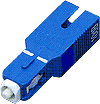Hybrid Fiber Optic Cables-Hybrid Fiber Cables- Hybrid Singlemode Fiber Optic Cable- Hybrid Multimode Fiber Optic Cable

Hybrid Fiber Optic Cables



American Tele Data Tech
Supply is a telecommunications based national stocking distributor of Hybrid Fiber Optic Cables, Hybrid Fiber Cables, Hybrid Singlemode Fiber Optic Cable, Hybrid Multimode Fiber Optic Cable,singlemode fiber optic cable and multimode fiber optic cables ranging from 2 fiber to 264 576 to 744 up to 864 for FTTX applications Our 744 count fiber to 864 count fiber strand to our 264 to 576 count fibers are mostly special order. Please call for lead times. We provide fiber cables from over 15 different manufacturers including Draka, OFS, Belden, AFL , Optical Cable and many more. Our warehouses located on both coasts allow for fast and reliable shipping of fiber optic cables throughout the USA and we also export all over the world. We have almost every type of fiber optic cable made for immediate or for special orders - the fastest turnaround in the industry. We have custom fiber jumpers and fiber assemblies at the USA's best prices as well. Call us today at (866) FIBER-21.
Fiber Optic Cable refers to the complete assembly of fibers, strength members and jacket. Fiber optic cables come in lots of different types, depending on the number of fibers and how and where it will be installed. Choose cable carefully as the choice will affect how easy it is to install, splice or terminate and, most important, what it will cost! We offer COMPLIMENTARY ENGINEERING at no cost for simple questions regarding fiber. For designing fiber networks or FTTH developments please ask for one of our engineers or visit one of our partners at ATEK for further assistance.
| |
Part Number |
Description |
 |
M-012-DN-6F-F06NS/GSM/40T |
Self-Support Fiber + Coax Outdoor Drop Cable Arid-Core Construction Direct Buried Loose Tube w/ F6 Quadshield Brightwire® Coax |
 |
M-012-DN-8W-F12NS/GSM/40T |
Self-Support Fiber + Coax Outdoor Drop Cable Arid-Core Construction Direct Buried Loose Tube w/ F6 Quadshield Brightwire® Coax |

Composite Wire Cable Transmissions Specifications
| |
Nominal OD
in (mm) |
Nominal |
Nominal
Vel. Prop |
Nominal Capcitance
pF/ft. (pF/m) |
Nominal Attentuation |
| MHz |
dB/100ft |
dB/100m |
| Conductor |
.040 (1.02) |
75 |
83% |
16.3 (53.5) |
5 |
0.6 |
2.0 |
| Dialectric |
.180 (4.57) |
|
|
|
10 |
0.8 |
2.6 |
| Final |
.298 (7.57) |
|
|
|
50 |
1.5 |
4.9 |
Construction: RG-6/U Type Quad Shielded Broadband Coaxial Cable, 18 AWG Solid Copper Covered Steel Conductor, 36Ω/kft, 118Ω/km. Cellular Polyethylene Dielectric. Quad Shielded, Bonded Aluminum Foil, 60% Aluminum Braid, Aluminum Foil, 40% Aluminum Braid. Overall PVC Jacket.
- Perfect for Use When Mixed Fiber Optic and/or Copper Media and Coaxial Cable is Required
- Suitable for Use in Residential Applications
- Supports Reduced Installation Costs and Simpler Cable Management
|
100 |
2.1 |
6.9 |
| 200 |
2.8 |
9.2 |
| 400 |
4.2 |
13.8 |
| 700 |
5.6 |
18.4 |
| 900 |
6.3 |
20.7 |
| 1000 |
6.7 |
22.0 |


Simplex and Zip Cord
 Simplex and Zip Cord: Simplex fiber optic cables are one fiber, tight-buffered (coated with a 900 micron buffer over the primary buffer coating) with Kevlar (aramid fiber) strength members and jacketed for indoor use. The jacket is usually 3mm (1/8 in.) diameter. Zipcord is simply two of these joined with a thin web. It's used mostly for patch cord and backplane applications, but zipcord can also be used for desktop connections.
Simplex and Zip Cord: Simplex fiber optic cables are one fiber, tight-buffered (coated with a 900 micron buffer over the primary buffer coating) with Kevlar (aramid fiber) strength members and jacketed for indoor use. The jacket is usually 3mm (1/8 in.) diameter. Zipcord is simply two of these joined with a thin web. It's used mostly for patch cord and backplane applications, but zipcord can also be used for desktop connections.
Distribution Cables

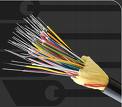 Distribution Cables: Distribution fiber optic cables contain several tight-buffered fibers bundled under the same jacket with Kevlar strength members and sometimes fiberglass rod reinforcement to stiffen the cable and prevent kinking. These cables are small in size, and used for short, dry conduit runs, riser and plenum applications. The fibers are double buffered and can be directly terminated, but because their fibers are not individually reinforced, these cables need to be broken out with a "breakout box" or terminated inside a patch panel or junction box.
Distribution Cables: Distribution fiber optic cables contain several tight-buffered fibers bundled under the same jacket with Kevlar strength members and sometimes fiberglass rod reinforcement to stiffen the cable and prevent kinking. These cables are small in size, and used for short, dry conduit runs, riser and plenum applications. The fibers are double buffered and can be directly terminated, but because their fibers are not individually reinforced, these cables need to be broken out with a "breakout box" or terminated inside a patch panel or junction box.
Breakout Cables

 Breakout Cables: Breakout Fiber Optic Cables are made of several simplex cables bundled together. This is a strong, rugged design, but is larger and more expensive than the distribution cables. It is suitable for conduit runs, riser and plenum applications. Because each fiber is individually reinforced, this design allows for quick termination to connectors and does not require patch panels or boxes. Breakout cable can be more economic where fiber count isn't too large and distances too long, because is requires so much less labor to terminate.
Breakout Cables: Breakout Fiber Optic Cables are made of several simplex cables bundled together. This is a strong, rugged design, but is larger and more expensive than the distribution cables. It is suitable for conduit runs, riser and plenum applications. Because each fiber is individually reinforced, this design allows for quick termination to connectors and does not require patch panels or boxes. Breakout cable can be more economic where fiber count isn't too large and distances too long, because is requires so much less labor to terminate.
Loose Tube Cables

 Loose Tube Cables: Loose Tube Fiber Optic cables are composed of several fibers together inside a small plastic tube, which are in turn wound around a central strength member and jacketed, providing a small, high fiber count cable. This type of cable is ideal for outside plant trunking applications, as it can be made with the loose tubes filled with gel or water absorbent powder to prevent harm to the fibers from water. It can be used in conduits, strung overhead or buried directly into the ground. Since the fibers have only a thin buffer coating, they must be carefully handled and protected to prevent damage.
Loose Tube Cables: Loose Tube Fiber Optic cables are composed of several fibers together inside a small plastic tube, which are in turn wound around a central strength member and jacketed, providing a small, high fiber count cable. This type of cable is ideal for outside plant trunking applications, as it can be made with the loose tubes filled with gel or water absorbent powder to prevent harm to the fibers from water. It can be used in conduits, strung overhead or buried directly into the ground. Since the fibers have only a thin buffer coating, they must be carefully handled and protected to prevent damage.
Ribbon Cable

 Ribbon Cable: Ribbon Fiber Optic Cables offer the highest packing density, since all the fibers are laid out in rows, typically of 12 fibers, and laid on top of each other. This way 144 fibers only has a cross section of about 1/4 inch or 6 mm! Some cable designs use a "slotted core" with up to 6 of these 144 fiber ribbon assemblies for 864 fibers in one cable! Since it's outside plant cable, it's gel-filled for water blocking.
Ribbon Cable: Ribbon Fiber Optic Cables offer the highest packing density, since all the fibers are laid out in rows, typically of 12 fibers, and laid on top of each other. This way 144 fibers only has a cross section of about 1/4 inch or 6 mm! Some cable designs use a "slotted core" with up to 6 of these 144 fiber ribbon assemblies for 864 fibers in one cable! Since it's outside plant cable, it's gel-filled for water blocking.
Armored Fiber Optic Cable

 Armored Cable: Armored Fiber Cable is used by the military, industrial applications as in petrochemical, industrial plants including nuclear and Utilities are installed by direct burial in areas where rodents are a problem usually have metal armoring between two jackets to prevent rodent penetration. This means the cable is conductive, so it must be grounded properly.
Armored Cable: Armored Fiber Cable is used by the military, industrial applications as in petrochemical, industrial plants including nuclear and Utilities are installed by direct burial in areas where rodents are a problem usually have metal armoring between two jackets to prevent rodent penetration. This means the cable is conductive, so it must be grounded properly.
Aerial Fiber Optic Cable

 Aerial Cable: Aerial cables are for outside installation on poles. They can be lashed to a messenger or another cable (common in CATV) or have metal or aramid strength members to make them self supporting.
Aerial Cable: Aerial cables are for outside installation on poles. They can be lashed to a messenger or another cable (common in CATV) or have metal or aramid strength members to make them self supporting.
Even more types are available: every manufacturer has it's own favorites, so it's a good idea to get literature from as many cable makers as possible. And check out the specialty or on-line suppliers like American Tele Data-; often they can save you a bundle by making special cable just for you, even in relative small quantities.

Indoor
Outdoor Cables-Indoor Outdoor Fiber Optic Jumpers-Fiber Optic
Assemblies 


 Custom
Fiber Optic Trunk Cables-Designed For Co-Locations-Central Offices- Featuring
single-mode and multi-mode fiber optic assemblies trunks and patch
cords in Ribbon Array, DFX, Tight Buffer, and Loose Tube construction
with plenum or riser jackets. Trunks are available with standard
connectors or the new LC, SC, and MU single body connectors available
from ConTech. Trunks may also be constructed with Loose Tube cable
which results in a 30% reduction in overall cable density. Patch
cords are available with standard connectors, with the new single
body connectors, and in 2 channel configurations. Ribbon Array
system components include external harnesses, pre-cabled patch
panels, coupling blocks, and the MTP and MP connectors. Multi-mode
1 Gigabit and 10 Gigabit 50 micron trunks are available, with
products tailored for the ESCON, FICON, & SAN environments
Custom
Fiber Optic Trunk Cables-Designed For Co-Locations-Central Offices- Featuring
single-mode and multi-mode fiber optic assemblies trunks and patch
cords in Ribbon Array, DFX, Tight Buffer, and Loose Tube construction
with plenum or riser jackets. Trunks are available with standard
connectors or the new LC, SC, and MU single body connectors available
from ConTech. Trunks may also be constructed with Loose Tube cable
which results in a 30% reduction in overall cable density. Patch
cords are available with standard connectors, with the new single
body connectors, and in 2 channel configurations. Ribbon Array
system components include external harnesses, pre-cabled patch
panels, coupling blocks, and the MTP and MP connectors. Multi-mode
1 Gigabit and 10 Gigabit 50 micron trunks are available, with
products tailored for the ESCON, FICON, & SAN environments
We Carry Fiber Optic Cable and The Complete Lines of CAT 5e , CAT 6, Coax & Specialty Cable From The Following Manufacturers
West
Coast Sales (866) 342-3721--------------East
Coast Sales (866) 650-3282
Type Of Fiber Optic Cable |
Description Of Fiber Optic Cable |
Fiber Optic Cable Applications |
FTTX- Fiber To The Home Cable |
|
Fiber To The Home Applications |
Singlemode Fiber Optic Cable |
|
Long Haul- DWDM-CO Trunking |
Multimode Fiber Optic Cable |
|
WAN/LAN- Indoor-riser |
Indoor-Outdoor Fiber Optic Cable |
|
Used Both Indoor and Outdoor |
Tight Buffer Fiber Optic Cable |
|
Indoor Cabling-Riser-Horizotnal |
Loose Tube Fiber Optic Cable |
|
Direct Bury- Large Count Feeder Data Cable |
Breakout Fiber Optic Cable |
|
Breakout cables combine multiple flexibility with the strength of individually jacketed fibers |
Zipcord Fiber Optic Cable |
|
Zip cord usually used in indoor applications, especially on fiber optic patch cable |
Composite Fiber Optic Cable |
|
Composite cable for use in indoor/outdoor applications -has a fiber optic core section |
Ribbon Fiber Optic Cable |
|
Manufacturing- Used In Board or Electronic Applications |
Armored Fiber Optic Cable |
|
Military- Rugged Applications |
Aerial Fiber Optic Cable |
|
Utility- Main Communications Distribution |
Current List Of Local Fiber Cable Stock |
|
|
We
specialize in building custom cable assemblies to meet specific requirements and
specifications. You can choose from assorted fiber optic cables and fiber optic
connectors from different manufacturers. We can terminate the fiber optic connector
in many different ways, which will save you money without comprising performance.
As with all of our fiber optic cable assemblies, all multi fiber cable assemblies
are individually inspected and tested for optical performance. In addition, we
provide CAD drawings to help you with the installation. You can choose from assorted
fiber optic cables and fiber optic connectors from different manufacturers. We
can terminate the fiber optic connector in many different ways, which will save
you money without comprising performance To ensure the products' performance, our
manufacturing process utilizes high quality fiber optic connectors with ceramic
ferrules (Or Bronze-if requested), and OFNR riser or higher graded fiber cables.
Our extensive range of fiber optic cable is available in 900um, 1.6mm and 3mm
jacketed fiber wires terminated with state-of-the-art connectors such as ST, SC,
FC, MTRJ and LC types to meet your standard or custom configurations.
 Specialty/Tactical Cables/Military
Specialty/Tactical Cables/Military
. Armored Cables
Armored Cables
 Mining
Fiber Optic Cable
Mining
Fiber Optic Cable
American Tele Data is one of the leading suppliers of fiber optic cables in the USA stocking hundreds of thousands of feet of fiber optic cables that are ready to ship same day including loose tube fiber optic cable, tight buffer fiber optic cable, aerial fiber optic cables, indoor outdoor fiber optic cables, ADSS cables, figure 8 fiber optic cables, military fiber optic cables,armored fiber optic cables, tactical fiber optic cables, and more in singlmode fiber, multimode fiber and multi fiber combinations- Call us at (866) 342-3721 and let one of customer technical executives assist you in your fiber cable selection.

 Loose Tube Fiber Optic Cables: Loose Tube Optic Outside Plant Cable is right for any outside plant application. Our loose tube cable constructions are built to withstand adverse environments and provide the maximum fiber protection. They can be installed in ducts, direct buried and aerial/lashed installations for trunk and fiber to the premise applications. Our outside plant products conform to TIA/EIA, ICEA, Telcordia and RUS standards.
Loose Tube Fiber Optic Cables: Loose Tube Optic Outside Plant Cable is right for any outside plant application. Our loose tube cable constructions are built to withstand adverse environments and provide the maximum fiber protection. They can be installed in ducts, direct buried and aerial/lashed installations for trunk and fiber to the premise applications. Our outside plant products conform to TIA/EIA, ICEA, Telcordia and RUS standards.
 Tight
Buffer Cables: Tight Buffered Fiber Optic is right for
any premise application. Our 900ųm tight buffer premise
cable constructions are built to withstand continuous handling
as well as difficult routing, both of which are typical in the
premise environment. Ideal for both backbone and horizontal applications,
900ųm premise cables allow for the direct termination of
connectors, saving installation time and reducing connectorization
costs. American Tele Dataoffers a complete line of totally dry outside
plant (OSP) cables. By eliminating messy gels and filling compounds
the handling and installation process is greatly streamlined,
resulting in higher efficiencies. These cables are available in
both loose tube or ribbon structures with dielectric and metallic
sheath options
Tight
Buffer Cables: Tight Buffered Fiber Optic is right for
any premise application. Our 900ųm tight buffer premise
cable constructions are built to withstand continuous handling
as well as difficult routing, both of which are typical in the
premise environment. Ideal for both backbone and horizontal applications,
900ųm premise cables allow for the direct termination of
connectors, saving installation time and reducing connectorization
costs. American Tele Dataoffers a complete line of totally dry outside
plant (OSP) cables. By eliminating messy gels and filling compounds
the handling and installation process is greatly streamlined,
resulting in higher efficiencies. These cables are available in
both loose tube or ribbon structures with dielectric and metallic
sheath options
.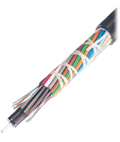 Indoor Outdoor Cables: Fiber Optic Indoor/Outdoor Cables are designed to meet both the stringent environmental requirements typical of outside plant cable AND the flammability requirements of premise applications. Ideal for applications that span indoor and outdoor environments, Indoor/outdoor cable can eliminate the need for building entryway splice points, saving both time and money. Outdoor/Indoor cables combine the flame resistance and safety features of an indoor riser or plenum cable with the durability that is critical for OSP use. The result is a unique, dual-purpose cable that can save time and money by allowing OSP applications to flow seamlessly indoors, using a single cable and no splices.
Indoor Outdoor Cables: Fiber Optic Indoor/Outdoor Cables are designed to meet both the stringent environmental requirements typical of outside plant cable AND the flammability requirements of premise applications. Ideal for applications that span indoor and outdoor environments, Indoor/outdoor cable can eliminate the need for building entryway splice points, saving both time and money. Outdoor/Indoor cables combine the flame resistance and safety features of an indoor riser or plenum cable with the durability that is critical for OSP use. The result is a unique, dual-purpose cable that can save time and money by allowing OSP applications to flow seamlessly indoors, using a single cable and no splices.
 Interconnect Fiber Optic Cables: Interconnect Cables can be used for horizontal fiber-to-the-desk (FTTD) cabling or can be terminated into pigtails and patch cords for use in data centers or wiring closets. Both tight buffer and ribbon-style constructions are compatible with industry-standard connectors.
Interconnect Fiber Optic Cables: Interconnect Cables can be used for horizontal fiber-to-the-desk (FTTD) cabling or can be terminated into pigtails and patch cords for use in data centers or wiring closets. Both tight buffer and ribbon-style constructions are compatible with industry-standard connectors.

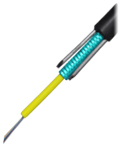 Drop Cable
Drop Cable
OFS offers compact, durable, and self-supporting drop cables in a completely dry construction. Reliable and cost-effective for the last link in the optical network, they are the ideal solution for self-supporting aerial, direct buried, and duct FTTx drop installations.

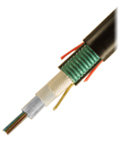 FTTx Cable
FTTx Cable
OFS offers leading-edge optical cables for fiber to the home, businesses, and multiple dwelling unit deployments, that are key components of our comprehensive Access ADVANTAGE™ System.
 Central Tube Cable
Central Tube Cable
OFS was the first optical cable manufacturer to introduce the central tube cable design, offering easy fiber access and maximum fiber density. The central tubes provide the cables with excellent optical, mechanical and environmental performance, making them suitable for a wide variety of deployments, including underground conduit and rugged direct buried applications.
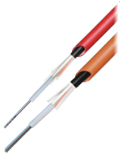 Microcables and Blown Fiber Units
Microcables and Blown Fiber Units
These microfiber fiber cables are revolutionary designs that increase the cost-effectiveness and range of deployment options for your network. These small, lightweight, and flexible fiber units help save time and money with fast and reliable microduct installation. Since fiber can be deployed only as needed, you enjoy better cost control, and can build "future-proof" networks
. Optical Ribbon
Optical Ribbon
OFS has led the industry in optical fiber ribbon technology by being the first to introduce fiber ribbons in 1975, as well as the first to introduce UV-curable acrylate material ribbons in 1989. Today's optical ribbon cables hold up to 24 colored optical fibers in a planar array, providing a high fiber density unit for use in fiber optic cabling or routing inside electronic equipment.
 Premises Cable
Premises Cable
Our premises fiber optic cables have a 20-year proven record. The premises distribution cable is ideal for use in systems in the central office, frame cabling environment, or FTTx. These cables are the first and only totally dry (greaseless), waterproof, tight buffered fiber optic indoor/outdoor cable in the industry, developed specifically to go from a manhole splice to the Central Office (CO) frame or from frame to frame between buildings. Our optical cordage offers outstanding performance and easy connectivity. All of our premises cable designs are fully qualified to industrially accepted specifications.
  Drop Cable Drop Cable
OFS offers compact, durable, and self-supporting drop cables in a completely dry construction. Reliable and cost-effective for the last link in the optical network, they are the ideal solution for self-supporting aerial, direct buried, and duct FTTx drop installations.
  FTTx Cable FTTx Cable
OFS offers leading-edge optical cables for fiber to the home, businesses, and multiple dwelling unit deployments, that are key components of our comprehensive Access ADVANTAGE™ System.
 Central Tube Cable Central Tube Cable
OFS was the first optical cable manufacturer to introduce the central tube cable design, offering easy fiber access and maximum fiber density. The central tubes provide the cables with excellent optical, mechanical and environmental performance, making them suitable for a wide variety of deployments, including underground conduit and rugged direct buried applications.
 Microcables and Blown Fiber Units Microcables and Blown Fiber Units
These microfiber fiber cables are revolutionary designs that increase the cost-effectiveness and range of deployment options for your network. These small, lightweight, and flexible fiber units help save time and money with fast and reliable microduct installation. Since fiber can be deployed only as needed, you enjoy better cost control, and can build "future-proof" networks
. Optical Ribbon Optical Ribbon
OFS has led the industry in optical fiber ribbon technology by being the first to introduce fiber ribbons in 1975, as well as the first to introduce UV-curable acrylate material ribbons in 1989. Today's optical ribbon cables hold up to 24 colored optical fibers in a planar array, providing a high fiber density unit for use in fiber optic cabling or routing inside electronic equipment.
 Premises Cable Premises Cable
Our premises fiber optic cables have a 20-year proven record. The premises distribution cable is ideal for use in systems in the central office, frame cabling environment, or FTTx. These cables are the first and only totally dry (greaseless), waterproof, tight buffered fiber optic indoor/outdoor cable in the industry, developed specifically to go from a manhole splice to the Central Office (CO) frame or from frame to frame between buildings. Our optical cordage offers outstanding performance and easy connectivity. All of our premises cable designs are fully qualified to industrially accepted specifications. |
ST
fiber optic patch cable
FC fiber cable assemblies
SC fiber cable assemblies
Biconic
fiber assemblies
FDDI cables
SMA
fiber assemblies
Escon fiber optics
MTRJ fiber patch cords
MU fiberoptics
FA
fibre cables
D4
optical fiber assemblies
E2000 fiber cable assemlbies
MTP optical fiber
MPO
optical fiber assemblies
Opti Jack fibre optics
Multimode 62.5/125 micron Duplex Fiber Optic Cable Assemblies
Multimode 50/125
micron Duplex Fiber Assemblies
Single-Mode 9/125 micron Duplex Fiber Patch
cords and Jumpers
Single-Mode Simplex Fiber Optic Cable Assemblies
Fiber
Optic Connectors
Fiber Optic Adapters
Bulk Fiber Optic Cable
Fiber
Optic Cables /Fiber Jumpers
Duplex MTRJ-MTRJ Fiber Optic Cable
Duplex
MTRJ-SC Fiber Optic Cable
Duplex MTRJ-ST Fiber Optic Cable
Multimode Duplex
SC-SC Fiber Optic Cable
Multimode Duplex ST-SC Fiber Optic Cable
Multimode
Duplex ST-ST Fiber Optic Cable
Multimode Duplex LC-ST Fiber Optic Cable
Multimode Duplex LC-LC Fiber Optic Cable
Multimode Duplex LC-MTRJ Fiber Optic
Cable
Multimode Duplex LC-SC Fiber Optic Cable
Singlemode Duplex SC-SC
Fiber Optic Cable
Singlemode Duplex ST-SC Fiber Optic Cable
Singlemode
Duplex ST-ST Fiber Optic Cable Assemblies Connectors
Description Part Number
ST -ST multi-mode, duplex PC ST/STD-XXX
ST -ST single
mode, duplex PC ST/STSD-XXX
ST -SC mm, duplex PC ST/SCD-XXX
ST-SC sm, duplex
PC ST/SCSD-XXX
SC-SC mm, duplex PC SC/SCD-XXX
SC-SC sm , duplex PC SC/SCSD-XXX
ST-LC
mm, duplex PC ST/LCD-XXX
ST-LC sm, duplex PC ST/LCSD-XXX
SC-LC mm, duplex
PC SC/LCD-XXX
SC-LC sm, duplex PC SC/LCSD-XXX
LC-LC mm, duplex PC LC/LCD-XXX
LC-LC
sm, duplex PC LC/LCSD-XXX
ST-MTRJ mm, duplex PC ST/MTD-XXX
SC-MTRJ mm, duplex
PC SC/MTD-XXX
MTRJ-MTRJ mm, duplex PC MT/MTD-XXX
MTRJ-LC mm, duplex PC MT/LCD-XXXBRIEF
OVER VIEW OF FIBER OPTIC CABLE ADVANTAGES OVER COPPER:•
SPEED: Fiber optic networks operate at high speeds - up into the gigabits
•
BANDWIDTH: large carrying capacity
• DISTANCE: Signals can be transmitted
further without needing to be "refreshed" or strengthened.
•
RESISTANCE: Greater resistance to electromagnetic noise such as radios, motors
or other nearby cables.
• MAINTENANCE: Fiber optic cables costs much less
to maintain.
In
recent years it has become apparent that fiber-optics are steadily replacing copper
wire as an appropriate means of communication signal transmission. They span the
long distances between local phone systems as well as providing the backbone for
many network systems. Other system users include cable television services, university
campuses, office buildings, industrial plants, and electric utility companies.A
fiber-optic system is similar to the copper wire system that fiber-optics is replacing.
The difference is that fiber-optics use light pulses to transmit information down
fiber lines instead of using electronic pulses to transmit information down copper
lines. Looking at the components in a fiber-optic chain will give a better understanding
of how the system works in conjunction with wire based systems.At
one end of the system is a transmitter. This is the place of origin for information
coming on to fiber-optic lines. The transmitter accepts coded electronic pulse
information coming from copper wire. It then processes and translates that information
into equivalently coded light pulses. A light-emitting diode (LED) or an injection-laser
diode (ILD) can be used for generating the light pulses. Using a lens, the light
pulses are funneled into the fiber-optic medium where they transmit themselves
down the line.Think
of a fiber cable in terms of very long cardboard roll (from the inside roll of
paper towel) that is coated with a mirror.
If you shine a flashlight in one
you can see light at the far end - even if bent the roll around a corner.Light
pulses move easily down the fiber-optic line because of a principle known as total
internal reflection. "This principle of total internal reflection states
that when the angle of incidence exceeds a critical value, light cannot get out
of the glass; instead, the light bounces back in. When this principle is applied
to the construction of the fiber-optic strand, it is possible to transmit information
down fiber lines in the form of light pulses.
Multimode cable is made of of
glass fibers, with a common diameters in the 50-to-100 micron range for the light
carry component (the most common size is 62.5). POF is a newer plastic-based cable
which promises performance similar to glass cable on very short runs, but at a
lower cost.Multimode
fiber gives you high bandwidth at high speeds over medium distances. Light waves
are dispersed into numerous paths, or modes, as they travel through the cable's
core typically 850 or 1300nm. Typical multimode fiber core diameters are 50, 62.5,
and 100 micrometers. However, in long cable runs (greater than 3000 feet [914.4
ml), multiple paths of light can cause signal distortion at the receiving end,
resulting in an unclear and incomplete data transmission. The use of fiber-optics
was generally not available until 1970 when Corning Glass Works was able to produce
a fiber with a loss of 20 dB/km. It was recognized that optical fiber would be
feasible for telecommunication transmission only if glass could be developed so
pure that attenuation would be 20dB/km or less. That is, 1% of the light would
remain after traveling 1 km. Today's optical fiber attenuation ranges from 0.5dB/km
to 1000dB/km depending on the optical fiber used. Attenuation limits are based
on intended application.The
applications of optical fiber communications have increased at a rapid rate, since
the first commercial installation of a fiber-optic system in 1977. Telephone companies
began early on, replacing their old copper wire systems with optical fiber lines.
Today's telephone companies use optical fiber throughout their system as the backbone
architecture and as the long-distance connection between city phone systems.Cable
television companies have also began integrating fiber-optics into their cable
systems. The trunk lines that connect central offices have generally been replaced
with optical fiber. Some providers have begun experimenting with fiber to the
curb using a fiber/coaxial hybrid. Such a hybrid allows for the integration of
fiber and coaxial at a neighborhood location. This location, called a node, would
provide the optical receiver that converts the light impulses back to electronic
signals. The signals could then be fed to individual homes via coaxial cable.Local
Area Networks (LAN) is a collective group of computers, or computer systems, connected
to each other allowing for shared program software or data bases. Colleges, universities,
office buildings, and industrial plants, just to name a few, all make use of optical
fiber within their LAN systems.
Power
companies are an emerging group that have begun to utilize fiber-optics
in their communication systems. Most power utilities already
have fiber-optic communication systems in use for monitoring
their power grid systems.















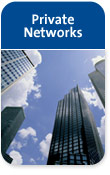
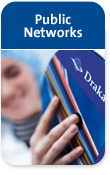




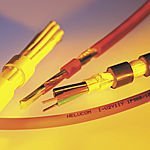

 Simplex and Zip Cord: Simplex fiber optic cables are one fiber, tight-buffered (coated with a 900 micron buffer over the primary buffer coating) with Kevlar (aramid fiber) strength members and jacketed for indoor use. The jacket is usually 3mm (1/8 in.) diameter. Zipcord is simply two of these joined with a thin web. It's used mostly for patch cord and backplane applications, but zipcord can also be used for desktop connections.
Simplex and Zip Cord: Simplex fiber optic cables are one fiber, tight-buffered (coated with a 900 micron buffer over the primary buffer coating) with Kevlar (aramid fiber) strength members and jacketed for indoor use. The jacket is usually 3mm (1/8 in.) diameter. Zipcord is simply two of these joined with a thin web. It's used mostly for patch cord and backplane applications, but zipcord can also be used for desktop connections. 
 Distribution Cables: Distribution fiber optic cables contain several tight-buffered fibers bundled under the same jacket with Kevlar strength members and sometimes fiberglass rod reinforcement to stiffen the cable and prevent kinking. These cables are small in size, and used for short, dry conduit runs, riser and plenum applications. The fibers are double buffered and can be directly terminated, but because their fibers are not individually reinforced, these cables need to be broken out with a "breakout box" or terminated inside a patch panel or junction box.
Distribution Cables: Distribution fiber optic cables contain several tight-buffered fibers bundled under the same jacket with Kevlar strength members and sometimes fiberglass rod reinforcement to stiffen the cable and prevent kinking. These cables are small in size, and used for short, dry conduit runs, riser and plenum applications. The fibers are double buffered and can be directly terminated, but because their fibers are not individually reinforced, these cables need to be broken out with a "breakout box" or terminated inside a patch panel or junction box. 

 Loose Tube Cables: Loose Tube Fiber Optic cables are composed of several fibers together inside a small plastic tube, which are in turn wound around a central strength member and jacketed, providing a small, high fiber count cable. This type of cable is ideal for outside plant trunking applications, as it can be made with the loose tubes filled with gel or water absorbent powder to prevent harm to the fibers from water. It can be used in conduits, strung overhead or buried directly into the ground. Since the fibers have only a thin buffer coating, they must be carefully handled and protected to prevent damage.
Loose Tube Cables: Loose Tube Fiber Optic cables are composed of several fibers together inside a small plastic tube, which are in turn wound around a central strength member and jacketed, providing a small, high fiber count cable. This type of cable is ideal for outside plant trunking applications, as it can be made with the loose tubes filled with gel or water absorbent powder to prevent harm to the fibers from water. It can be used in conduits, strung overhead or buried directly into the ground. Since the fibers have only a thin buffer coating, they must be carefully handled and protected to prevent damage. 
 Ribbon Cable: Ribbon Fiber Optic Cables offer the highest packing density, since all the fibers are laid out in rows, typically of 12 fibers, and laid on top of each other. This way 144 fibers only has a cross section of about 1/4 inch or 6 mm! Some cable designs use a "slotted core" with up to 6 of these 144 fiber ribbon assemblies for 864 fibers in one cable! Since it's outside plant cable, it's gel-filled for water blocking.
Ribbon Cable: Ribbon Fiber Optic Cables offer the highest packing density, since all the fibers are laid out in rows, typically of 12 fibers, and laid on top of each other. This way 144 fibers only has a cross section of about 1/4 inch or 6 mm! Some cable designs use a "slotted core" with up to 6 of these 144 fiber ribbon assemblies for 864 fibers in one cable! Since it's outside plant cable, it's gel-filled for water blocking. 
 Armored Cable: Armored Fiber Cable is used by the military, industrial applications as in petrochemical, industrial plants including nuclear and Utilities are installed by direct burial in areas where rodents are a problem usually have metal armoring between two jackets to prevent rodent penetration. This means the cable is conductive, so it must be grounded properly.
Armored Cable: Armored Fiber Cable is used by the military, industrial applications as in petrochemical, industrial plants including nuclear and Utilities are installed by direct burial in areas where rodents are a problem usually have metal armoring between two jackets to prevent rodent penetration. This means the cable is conductive, so it must be grounded properly. 
 Aerial Cable: Aerial cables are for outside installation on poles. They can be lashed to a messenger or another cable (common in CATV) or have metal or aramid strength members to make them self supporting.
Aerial Cable: Aerial cables are for outside installation on poles. They can be lashed to a messenger or another cable (common in CATV) or have metal or aramid strength members to make them self supporting. 





 Specialty/Tactical Cables/Military
Specialty/Tactical Cables/Military Armored Cables
Armored Cables Mining
Fiber Optic Cable
Mining
Fiber Optic Cable
 Loose Tube Fiber Optic Cables: Loose Tube Optic Outside Plant Cable is right for any outside plant application. Our loose tube cable constructions are built to withstand adverse environments and provide the maximum fiber protection. They can be installed in ducts, direct buried and aerial/lashed installations for trunk and fiber to the premise applications. Our outside plant products conform to TIA/EIA, ICEA, Telcordia and RUS standards.
Loose Tube Fiber Optic Cables: Loose Tube Optic Outside Plant Cable is right for any outside plant application. Our loose tube cable constructions are built to withstand adverse environments and provide the maximum fiber protection. They can be installed in ducts, direct buried and aerial/lashed installations for trunk and fiber to the premise applications. Our outside plant products conform to TIA/EIA, ICEA, Telcordia and RUS standards. Tight
Buffer Cables: Tight Buffered Fiber Optic is right for
any premise application. Our 900ųm tight buffer premise
cable constructions are built to withstand continuous handling
as well as difficult routing, both of which are typical in the
premise environment. Ideal for both backbone and horizontal applications,
900ųm premise cables allow for the direct termination of
connectors, saving installation time and reducing connectorization
costs. American Tele Dataoffers a complete line of totally dry outside
plant (OSP) cables. By eliminating messy gels and filling compounds
the handling and installation process is greatly streamlined,
resulting in higher efficiencies. These cables are available in
both loose tube or ribbon structures with dielectric and metallic
sheath options
Tight
Buffer Cables: Tight Buffered Fiber Optic is right for
any premise application. Our 900ųm tight buffer premise
cable constructions are built to withstand continuous handling
as well as difficult routing, both of which are typical in the
premise environment. Ideal for both backbone and horizontal applications,
900ųm premise cables allow for the direct termination of
connectors, saving installation time and reducing connectorization
costs. American Tele Dataoffers a complete line of totally dry outside
plant (OSP) cables. By eliminating messy gels and filling compounds
the handling and installation process is greatly streamlined,
resulting in higher efficiencies. These cables are available in
both loose tube or ribbon structures with dielectric and metallic
sheath options Indoor Outdoor Cables: Fiber Optic Indoor/Outdoor Cables are designed to meet both the stringent environmental requirements typical of outside plant cable AND the flammability requirements of premise applications. Ideal for applications that span indoor and outdoor environments, Indoor/outdoor cable can eliminate the need for building entryway splice points, saving both time and money. Outdoor/Indoor cables combine the flame resistance and safety features of an indoor riser or plenum cable with the durability that is critical for OSP use. The result is a unique, dual-purpose cable that can save time and money by allowing OSP applications to flow seamlessly indoors, using a single cable and no splices.
Indoor Outdoor Cables: Fiber Optic Indoor/Outdoor Cables are designed to meet both the stringent environmental requirements typical of outside plant cable AND the flammability requirements of premise applications. Ideal for applications that span indoor and outdoor environments, Indoor/outdoor cable can eliminate the need for building entryway splice points, saving both time and money. Outdoor/Indoor cables combine the flame resistance and safety features of an indoor riser or plenum cable with the durability that is critical for OSP use. The result is a unique, dual-purpose cable that can save time and money by allowing OSP applications to flow seamlessly indoors, using a single cable and no splices. 
 Drop Cable
Drop Cable
 FTTx Cable
FTTx Cable Central Tube Cable
Central Tube Cable Microcables and Blown Fiber Units
Microcables and Blown Fiber Units Optical Ribbon
Optical Ribbon




